Get started with Docker for Mac
Estimated reading time: 15 minutesWelcome to Docker for Mac!
Docker is a full development platform for creating containerized apps, and Docker for Mac is the best way to get started with Docker on a Mac.
Got Docker for Mac? If you have not yet installed Docker for Mac, please see Install Docker for Mac for an explanation of stable and edge channels, system requirements, and download/install information.
Looking for system requirements? Check out What to know before you install, which has moved to the new install topic.
Check versions of Docker Engine, Compose, and Machine
Run these commands to test if your versions of docker, docker-compose, and
docker-machine are up-to-date and compatible with Docker.app.
$ docker --version
Docker version 17.03.0-ce, build 60ccb22
$ docker-compose --version
docker-compose version 1.11.2, build dfed245
$ docker-machine --version
docker-machine version 0.10.0, build 76ed2a6
Note: The above is an example. Your output will differ if you are running different (e.g., newer) versions.
Explore the application and run examples
-
Open a command-line terminal, and run some Docker commands to verify that Docker is working as expected.
Some good commands to try are
docker versionto check that you have the latest release installed, anddocker psanddocker run hello-worldto verify that Docker is running. -
For something more adventurous, start a Dockerized web server.
docker run -d -p 80:80 --name webserver nginxIf the image is not found locally, Docker will pull it from Docker Hub.
In a web browser, go to
http://localhost/to bring up the home page. (Since you specified the default HTTP port, it isn’t necessary to append:80at the end of the URL.)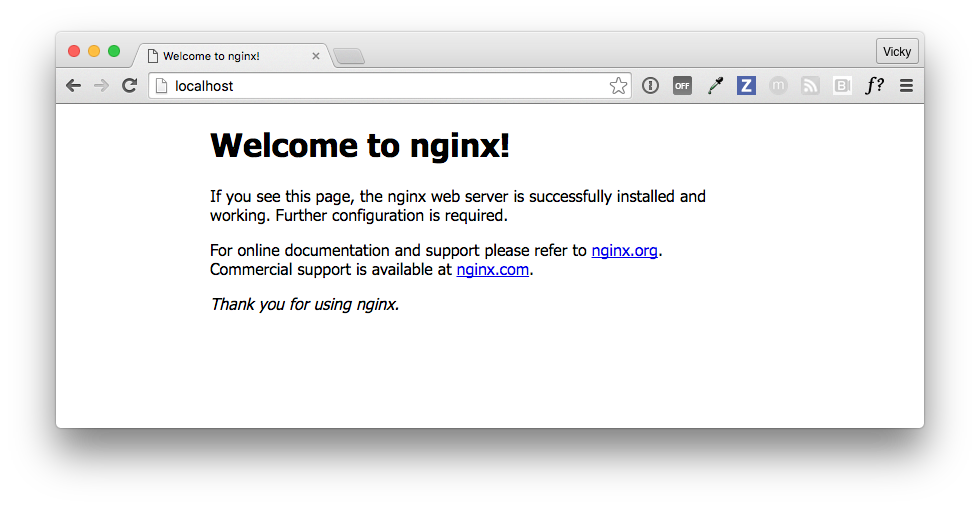
Note: Early beta releases used
dockeras the hostname to build the URL. Now, ports are exposed on the private IP addresses of the VM and forwarded tolocalhostwith no other host name set. See also, Release Notes for Beta 9. -
Run
docker pswhile your web server is running to see details on the webserver container.CONTAINER ID IMAGE COMMAND CREATED STATUS PORTS NAMES 56f433965490 nginx "nginx -g 'daemon off" About a minute ago Up About a minute 0.0.0.0:80->80/tcp, 443/tcp webserver -
Stop or remove containers and images.
The
nginxwebserver will continue to run in the container on that port until you stop and/or remove the container. If you want to stop the webserver, type:docker stop webserverand start it again withdocker start webserver. A stopped container will not show up withdocker ps; for that, you need to rundocker ps -a.To stop and remove the running container with a single command, type:
docker rm -f webserver. This will remove the container, but not thenginximage. You can list local images withdocker images. You might want to keep some images around so that you don’t have to pull them again from Docker Hub. To remove an image you no longer need, usedocker rmifollowed by an image ID or image name. For example,docker rmi nginx.
Want more example applications? Get Started and Samples are great places to start.
Preferences
Choose  ->
Preferences from the menu bar.
->
Preferences from the menu bar.
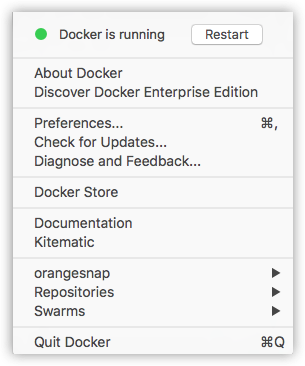
You can set the following runtime options.
Note: The above example shows a user signed in for integrated Docker Cloud access. To learn more about the feature, see Docker Cloud.
General

Auto-start, update, backups, usage data
-
Docker for Mac is set to automatically start Docker when you log in. Uncheck this option if you don’t want Docker to start when you open your session.
-
Docker for Mac is set to automatically check for updates and notify you when an update is available. If an update is found, click OK to accept and install it (or cancel to keep the current version). If you disable the check for updates, you can still find out about updates manually by choosing
 -> Check for Updates.
-> Check for Updates. -
Check Include VM in Time Machine backups to back up the Docker for Mac virtual machine. (By default, this is unchecked.)
-
You have the option to Securely store Docker logins in MacOS keychain, enabled by default. To “opt out” of storing your Docker login credentials, uncheck this option.
-
Send usage statistics — You can set Docker for Mac to auto-send diagnostics, crash reports, and usage data. This information can help Docker improve the application and get more context for troubleshooting problems. Uncheck this to opt out and prevent auto-send of data. Docker may prompt for more information in some cases, even with auto-send enabled.
File sharing
You can decide which directories on your Mac to share with containers.
-
Add a Directory - Click
+and navigate to the directory you want to add.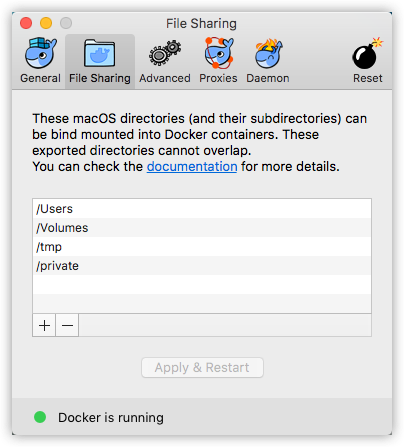
-
Click Apply & Restart to make the directory available to containers using Docker’s bind mount (
-v) feature.There are some limitations on the directories that can be shared:
-
They cannot be a subdirectory of an already shared directory.
-
They cannot already exist inside of Docker.
-
See Namespaces in the topic on osxfs file system sharing for more information.
Tip: File sharing is required for volume mounting if the project lives outside of the
/Usersdirectory. In that case, share the drive where the Dockerfile and volume are located. Otherwise, you will get file not found or cannot start service errors at runtime. (See also Volume mounting requires file sharing for any project directories outside of/Users.)
Advanced
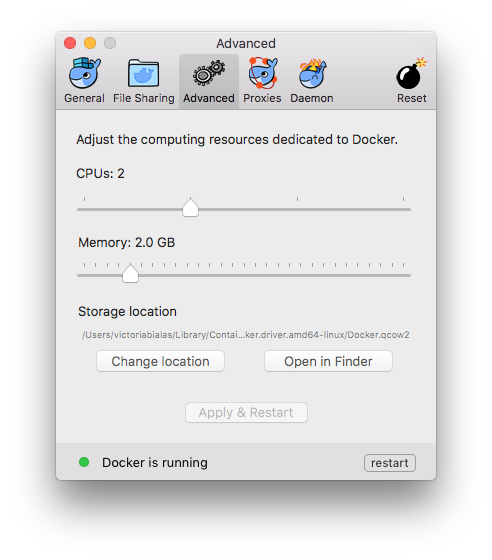
CPUs
By default, Docker for Mac is set to use half the number of processors available on the host machine. You can increase processing power for the app by setting this to a higher number, or lower it to have Docker for Mac use fewer computing resources.
Memory
By default, Docker for Mac is set to use 2 GB runtime memory, allocated from
the total available memory on your Mac. You can increase the RAM on the app to
get faster performance by setting this number higher (for example to 3) or
lower (to 1) if you want Docker for Mac to use less memory.
Disk image location (storage)
You can specify the Disk image location of the Linux volume; i.e., where containers and images are stored.
You can move the disk image location.
If you attempt to move the disk image to a location that already has one, you will get a prompt asking if you want to use the existing image or replace it.
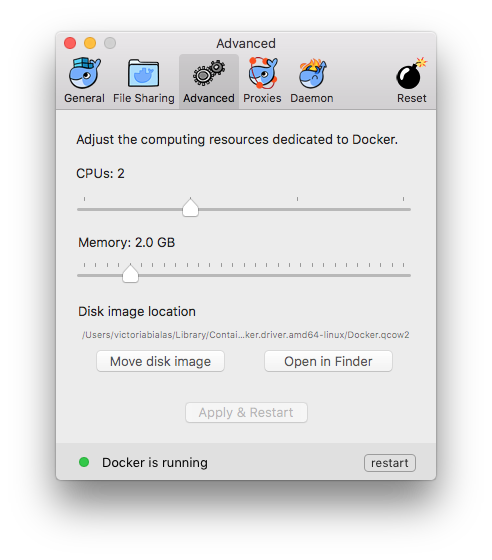
HTTP proxy settings
Docker for Mac will detect HTTP/HTTPS Proxy Settings and automatically propagate
these to Docker and to your containers. For example, if you set your proxy
settings to http://proxy.example.com, Docker will use this proxy when pulling
containers.
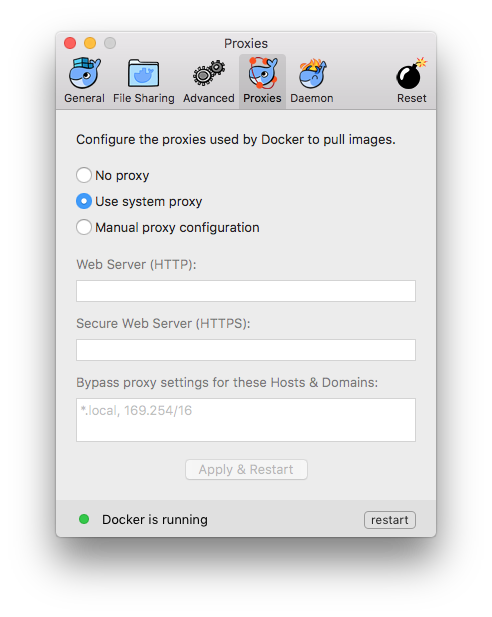
Docker Daemon
You can configure options on the Docker daemon that determine how your containers will run. You can configure some Basic options on the daemon with interactive settings, or switch to Advanced to edit the JSON directly.
The settings offered on Basic dialog can be configured directly in the JSON as well. This version just surfaces some of the common settings to make it easier to configure them.
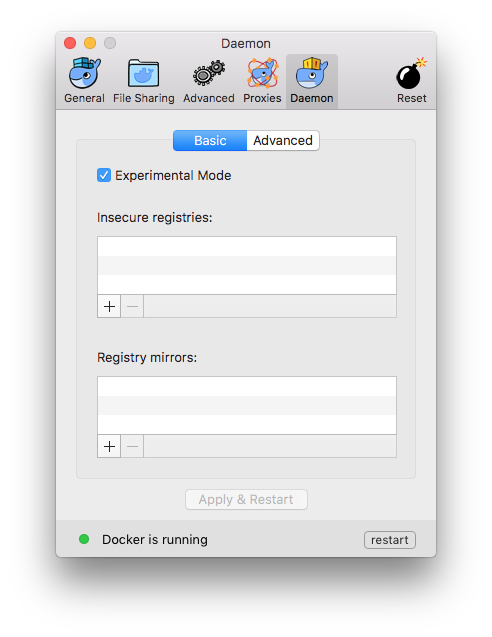
Experimental mode
Both Docker for Mac Stable and Edge releases have experimental features enabled on Docker Engine, as described in the Docker Experimental Features README on GitHub.
Experimental features are not appropriate for production environments or workloads. They are meant to be sandbox experiments for new ideas. Some experimental features may become incorporated into upcoming stable releases, but others may be modified or pulled from subsequent Edge releases, and never released on Stable.
On both Edge and Stable releases, you can toggle experimental mode on and off. If you toggle it off, Docker for Mac uses the current generally available release of Docker Engine.
You can check whether you are running experimental mode or not by typing docker
version on the command line. Experimental mode is listed under Server data.
If Experimental is true, then Docker is running in experimental mode, as
shown here. (If false, Experimental mode is off.)
$ docker version
Client:
Version: 1.13.0-rc3
API version: 1.25
Go version: go1.7.3
Git commit: 4d92237
Built: Tue Dec 6 01:15:44 2016
OS/Arch: darwin/amd64
Server:
Version: 1.13.0-rc3
API version: 1.25 (minimum version 1.12)
Go version: go1.7.3
Git commit: 4d92237
Built: Tue Dec 6 01:15:44 2016
OS/Arch: linux/amd64
Experimental: true
Custom registries
As an alternative to using Docker Hub to store your public or private images or Docker Trusted Registry, you can use Docker to set up your own insecure registry. Add URLs for insecure registries and registry mirrors on which to host your images.
See also, How do I add custom CA certificates? and How do I add client certificates in the FAQs.
Edit the daemon configuration file
On the Daemon -> Advanced dialog, you can directly configure the daemon from the JSON file, and determine entirely how your containers will run. For a full list of options on the Docker daemon, see daemon in the Docker Engine command line reference.
After editing the daemon configuration , click Apply & Restart to save it and reboot Docker. Or, to cancel changes, click another preference tab, then choose to discard or not apply changes when asked.
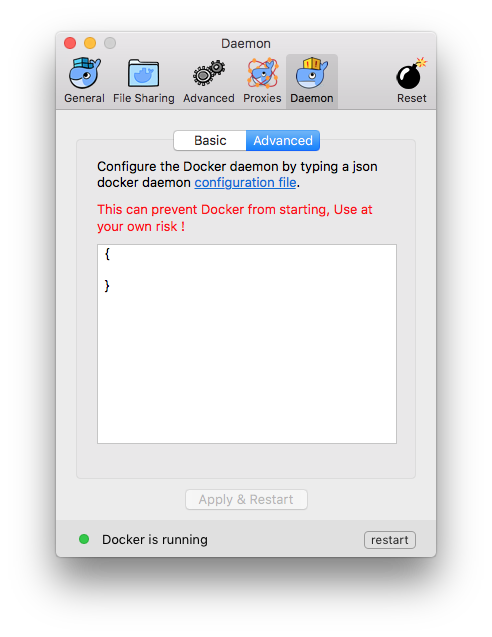
Uninstall or reset
Choose  ->
Preferences from the menu bar, then click Uninstall / Reset on the
Preferences dialog.
->
Preferences from the menu bar, then click Uninstall / Reset on the
Preferences dialog.
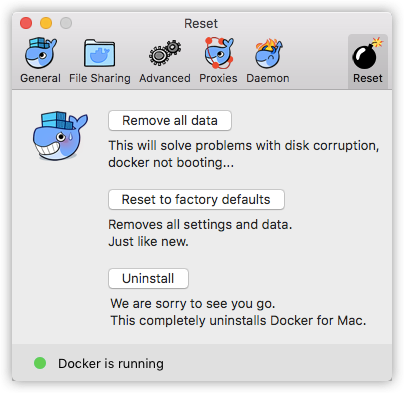
-
Remove all data - This option removes/resets all Docker data without a reset to factory defaults (which would cause you to lose settings).
-
Uninstall - Choose this option to remove Docker for Mac from your system.
-
Reset to factory defaults - Choose this option to reset all options on Docker for Mac to its initial state, the same as when it was first installed.
Uninstall from the command line
Alternatively, you can uninstall Docker for Mac from the command line with this
command: <DockerforMacPath> --uninstall. If Docker is installed in the default
location, the following command will provide a clean uninstall.
$ /Applications/Docker.app/Contents/MacOS/Docker --uninstall
Docker is running, exiting...
Docker uninstalled successfully. You can move the Docker application to the trash.
You might want to use the command-line uninstall if, for example, you find that the app is non-functional, and you cannot uninstall it from the menu.
Add TLS certificates
You can add trusted Certificate Authorities (CAs) (used to verify registry server certificates) and client certificates (used to authenticate to registries) to your Docker daemon.
Add custom CA certificates (server side)
All trusted CAs (root or intermediate) are supported. Docker for Mac creates a certificate bundle of all user-trusted CAs based on the Mac Keychain, and appends it to Moby trusted certificates. So if an enterprise SSL certificate is trusted by the user on the host, it will be trusted by Docker for Mac.
To manually add a custom, self-signed certificate, start by adding the certificate to the Mac’s keychain, which will be picked up by Docker for Mac. Here is an example.
sudo security add-trusted-cert -d -r trustRoot -k /Library/Keychains/System.keychain ca.crt
Or, if you prefer to add the certificate to your own local keychain only (rather than for all users), run this command instead:
security add-trusted-cert -d -r trustRoot -k ~/Library/Keychains/login.keychain ca.crt
See also, Directory structures for certificates.
Note: You need to restart Docker for Mac after making any changes to the keychain or to the
~/.docker/certs.ddirectory in order for the changes to take effect.
For a complete explanation of how to do this, see the blog post Adding Self-signed Registry Certs to Docker & Docker for Mac.
Add client certificates
You can put your client certificates in
~/.docker/certs.d/<MyRegistry>:<Port>/client.cert and
~/.docker/certs.d/<MyRegistry>:<Port>/client.key.
When the Docker for Mac application starts up, it copies the ~/.docker/certs.d
folder on your Mac to the /etc/docker/certs.d directory on Moby (the Docker
for Mac xhyve virtual machine).
You need to restart Docker for Mac after making any changes to the keychain or to the
~/.docker/certs.ddirectory in order for the changes to take effect.The registry cannot be listed as an insecure registry (see Docker Daemon). Docker for Mac will ignore certificates listed under insecure registries, and will not send client certificates. Commands like
docker runthat attempt to pull from the registry will produce error messages on the command line, as well as on the registry.
Directory structures for certificates
If you have this directory structure, you do not need to manually add the CA certificate to your Mac OS system login:
/Users/<user>/.docker/certs.d/
└── <MyRegistry>:<Port>
├── ca.crt
├── client.cert
└── client.key
The following further illustrates and explains a configuration with custom certificates:
/etc/docker/certs.d/ <-- Certificate directory
└── localhost:5000 <-- Hostname:port
├── client.cert <-- Client certificate
├── client.key <-- Client key
└── ca.crt <-- Certificate authority that signed
the registry certificate
You can also have this directory structure, as long as the CA certificate is also in your keychain.
/Users/<user>/.docker/certs.d/
└── <MyRegistry>:<Port>
├── client.cert
└── client.key
To learn more about how to install a CA root certificate for the registry and how to set the client TLS certificate for verification, see Verify repository client with certificates in the Docker Engine topics.
Install bash completion
If you are using bash
completion,
such as homebrew bash-completion on
Mac bash
completion scripts for the following commands may be found inside Docker.app,
in the Contents/Resources/etc/ directory:
- docker
- docker-machine
- docker-compose
To activate bash completion, these files need to be copied or symlinked to your
bash_completion.d/ directory. For example, if you use
Homebrew:
ln -s /Applications/Docker.app/Contents/Resources/etc/docker.bash-completion /usr/local/etc/bash_completion.d/docker
ln -s /Applications/Docker.app/Contents/Resources/etc/docker-machine.bash-completion /usr/local/etc/bash_completion.d/docker-machine
ln -s /Applications/Docker.app/Contents/Resources/etc/docker-compose.bash-completion /usr/local/etc/bash_completion.d/docker-compose
Give feedback and get help
To get help from the community, review current user topics, join or start a discussion, log on to our Docker for Mac forum.
To report bugs or problems, log on to Docker for Mac issues on GitHub, where you can review community reported issues, and file new ones. See Diagnose problems, send feedback, and create GitHub issues. As a part of reporting issues on GitHub, we can help you troubleshoot the log data.
To give us feedback on the documentation or update it yourself, use the Feedback options at the bottom of each docs page.
Docker Store
Choose Docker Store from the Docker for Mac menu to get to the Docker app downloads site. Docker store is a component of the next-generation Docker Hub, and the best place to find compliant, trusted commercial and free software distributed as Docker Images.
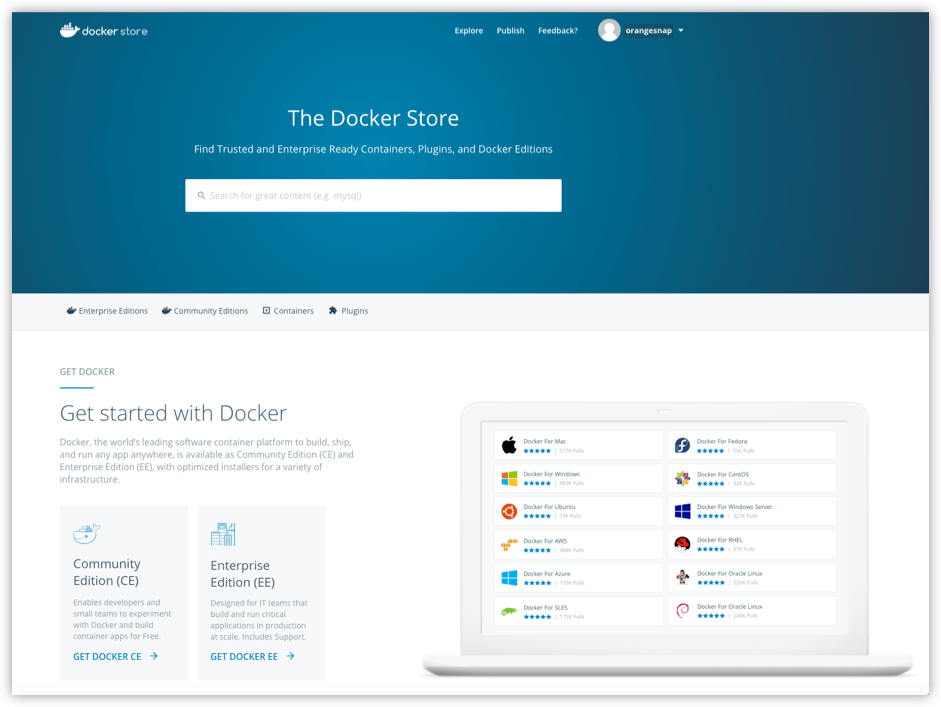
Docker Cloud
You can access your Docker Cloud account from within Docker for Mac.
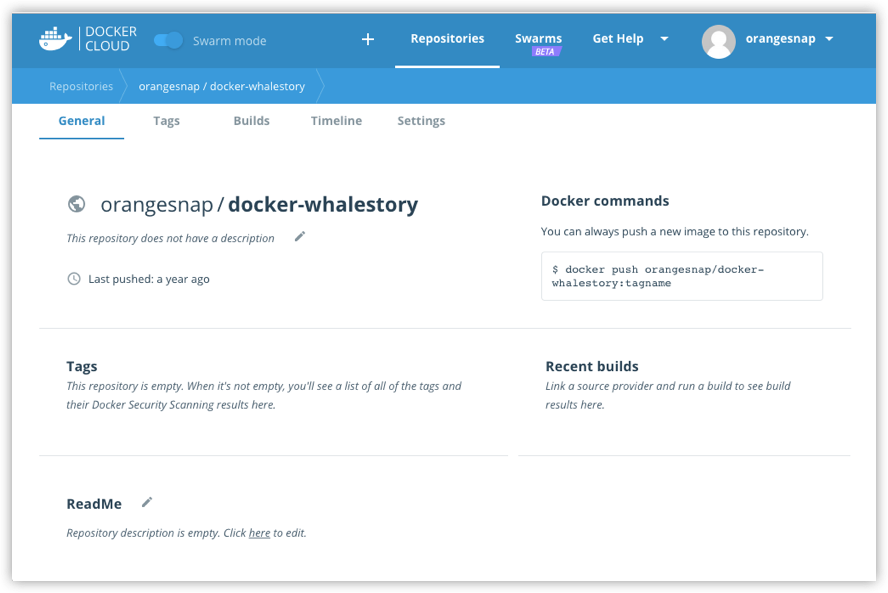
From the Docker for Mac menu, sign in to Docker Cloud with your Docker ID, or create one.
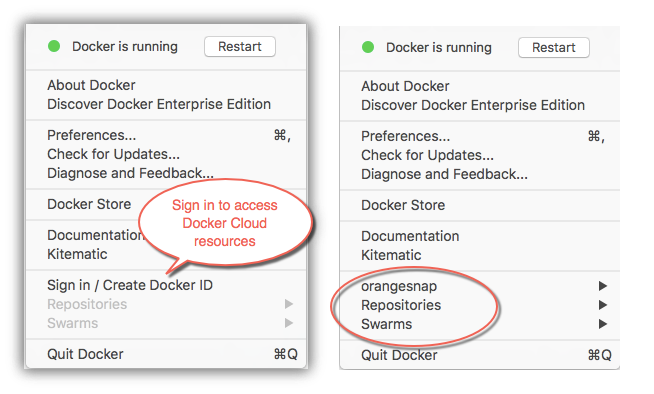
Then use the Docker for Mac menu to create, view, or navigate directly to your Cloud resources, including organizations, repositories, and swarms.
Check out these Docker Cloud topics to learn more:
Need a direct link to Cloud? Take me to Docker Cloud.
Where to go next
-
Try out the walkthrough at Get Started.
-
Dig in deeper with Docker Labs example walkthroughs and source code.
-
For a summary of Docker command line interface (CLI) commands, see Docker CLI Reference Guide.
-
Check out the blog post Introducing Docker 1.13.0.